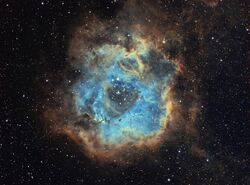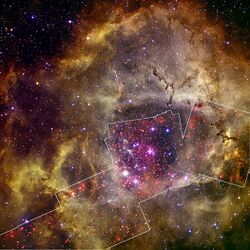Astronomy:Rosette Nebula
| Emission nebula | |
|---|---|
| H II region | |
 | |
| Observation data: J2000.0 epoch | |
| Right ascension | 06h 33m 45s[1] |
| Declination | +04° 59′ 54″[1] |
| Distance | 5,200[2] ly (1,600 pc) |
| Apparent magnitude (V) | 9.0 |
| Apparent dimensions (V) | 1.3 ° |
| Constellation | Monoceros |
| Physical characteristics | |
| Radius | 65 ly |
| Notable features | Multipart nebula |
| Designations | SH 2-275,[1] CTB 21,[1] Caldwell 49 |
The Rosette Nebula (also known as Caldwell 49) is an H II region located near one end of a giant molecular cloud in the Monoceros region of the Milky Way Galaxy. The open cluster NGC 2244 (Caldwell 50) is closely associated with the nebulosity, the stars of the cluster having been formed from the nebula's matter.
The nebula has been noted to be having a shape reminiscent of a human skull, and is sometimes referred to as the "Skull Nebula." It is not to be confused with NGC 246, which is also nicknamed the "Skull Nebula."[3][4]
Description
The complex has the following New General Catalogue (NGC) designations:
- NGC 2237 – Part of the nebulous region (Also used to denote whole nebula)
- NGC 2238 – Part of the nebulous region
- NGC 2239 – Part of the nebulous region (Discovered by John Herschel)
- NGC 2244 – The open cluster within the nebula (Discovered by John Flamsteed in 1690)[citation needed]
- NGC 2246 – Part of the nebulous region
The cluster and nebula lie at a distance of 5,000 light-years from Earth[5] and measure roughly 130 light years in diameter. The radiation from the young stars excites the atoms in the nebula, causing them to emit radiation themselves producing the emission nebula we see. The mass of the nebula is estimated to be around 10,000 solar masses.
A survey of the nebula with the Chandra X-ray Observatory has revealed the presence of numerous new-born stars inside optical Rosette Nebula and studded within a dense molecular cloud. Altogether, approximately 2500 young stars lie in this star-forming complex, including the massive O-type stars HD 46223 and HD 46150, which are primarily responsible for blowing the ionized bubble.[6][7] Most of the ongoing star-formation activity is occurring in the dense molecular cloud to the south east of the bubble.[8]
A diffuse X-ray glow is also seen between the stars in the bubble, which has been attributed to a super-hot plasma with temperatures ranging from 1 to 10 million K.[9] This is significantly hotter than the 10,000 K plasmas seen in HII regions, and is likely attributed to the shock-heated winds from the massive O-type stars.
On April 16, 2019 the Oklahoma Legislature passed HB1292 making the Rosette Nebula as the official state astronomical object. Oklahoma Governor Kevin Stitt signed it into law April 22, 2019.[10]
See also
References
- ↑ 1.0 1.1 1.2 1.3 "NGC 2237". SIMBAD. Centre de données astronomiques de Strasbourg. http://simbad.u-strasbg.fr/simbad/sim-basic?Ident=NGC+2237.
- ↑ Phelps, Randy L.; Ybarra, Jason E. (2005). "A Parsec-Scale Outflow in the Rosette Molecular Cloud?". The Astrophysical Journal 627 (2): 845–849. doi:10.1086/430431. Bibcode: 2005ApJ...627..845P.
- ↑ "A hole in the heart of the Rosette Nebula". 14 February 2018. https://www.cnn.com/2018/02/14/world/rosette-nebula-heart/index.html.
- ↑ "The Rosette Nebula | Astrophotography Through a Telescope". https://astrobackyard.com/caldwell-49-rosette-nebula/.
- ↑ 'Cambridge Deep Sky Companions - The Caldwell Objects' , S.J. O'Meara & P. Moore, Cambridge University Press, ISBN:0-521-82796-5 (2002)
- ↑ Kuhn, M. A. et al. (2015). "The Spatial Structure of Young Stellar Clusters. II. Total Young Stellar Populations". Astrophysical Journal 802 (1): 60. doi:10.1088/0004-637X/802/1/60. Bibcode: 2015ApJ...802...60K.
- ↑ Wang, J. (2008). "AChandra Study of the Rosette Star‐forming Complex. I. The Stellar Population and Structure of the Young Open Cluster NGC 2244". Astrophysical Journal 675 (1): 464–490. doi:10.1086/526406. Bibcode: 2008ApJ...675..464W.
- ↑ Ybarra, J. E. (2013). "The Progression of Star Formation in the Rosette Molecular Cloud". Astrophysical Journal 769 (2): 140. doi:10.1088/0004-637X/769/2/140. Bibcode: 2013ApJ...769..140Y.
- ↑ Townsley, L. K. (2003). "10 MK Gas in M17 and the Rosette Nebula: X-Ray Flows in Galactic H II Regions". Astrophysical Journal 593 (2): 874–905. doi:10.1086/376692. Bibcode: 2003ApJ...593..874T.
- ↑ "Bill Information". http://www.oklegislature.gov/BillInfo.aspx?Bill=HB1292&Session=1900.
External links
- Rosette Nebula (SEDS)
- Chandra Observatory study of the Rosette Nebula
- NOAO; "Fitful Young Star Sputters to Maturity in the Rosette Nebula"
- NightSkyInfo.com – Rosette Nebula
- Astronomy Picture of the Day
- Dust Sculptures in the Rosette Nebula – 2007 June 6
- Dust Sculptures in the Rosette Nebula – 2009 December 2
- Field of Rosette – 2010 February 14
- Slooh Videocast on Rosette Nebula
- Rosette Nebula from the Netherlands
- Deep image of the Rosette Nebula
- The Scale of the Universe (Astronomy Picture of the Day 2012 March 12)
- Rosette Nebula on WikiSky: DSS2, SDSS, GALEX, IRAS, Hydrogen α, X-Ray, Astrophoto, Sky Map, Articles and images
- Rosette Nebula at Constellation Guide
- Creative Commons Rosette Nebula, Data Download & Processing Guide
 |


